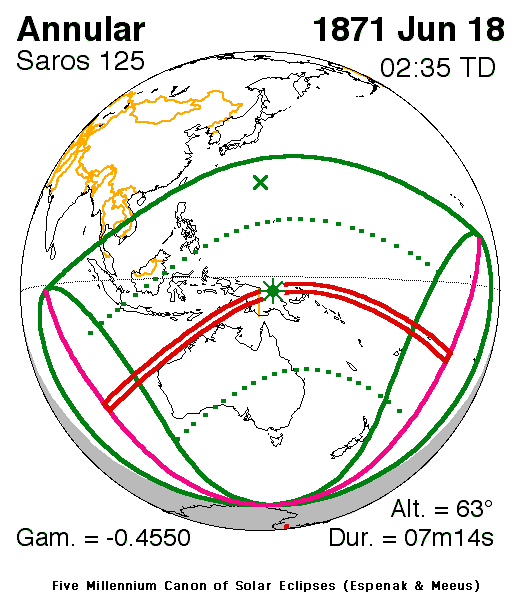An annular eclipse of the Sun occurred on Sunday 18 June, 1871 UT (6 Jun, 1871 Old Style), with maximum eclipse at 02:35 UT. The Sun was 95% covered in a moderate annular eclipse, lasting 7 minutes and 14 seconds and covering a broad path up to 214 km wide.
The annular eclipse lasted for 7 minutes and 14 seconds.
Maximum eclipse was at 02:35:03 UT.
During this eclipse the Sun was 0.525° in apparent
diameter, 1.6% smaller than average. The Moon was just a day past apogee, making it very small.
At maximum eclipse it was 0.497° in
apparent diameter, which is 6.3% smaller than average; this was not
large enough to cover the Sun, which is why this
was an annular eclipse.
The statistics page has information on the ranges of the sizes of
the Sun and Moon, and the Moon data page displays detailed
information on the Moon's key dates.
Overview Map
This map sourced from NASA Goddard Space flight Center: GSFC Eclipse Web SiteGSFC Eclipse Web Site
The primary source of all the information on eclipses presented here at Hermit Eclipse. (NASA Goddard Space flight Center)
shows the visibility of the annular solar eclipse. It also shows the broader area in which a partial eclipse was seen. (Click on it for the
full-sized version.)
Eclipse Season and Saros Series
This eclipse season contains 2 eclipses:
This was the 46th eclipse in solar Saros series 125.The surrounding eclipses in this Saros series are:
This Saros series, solar Saros series 125,
is linked to lunar Saros series 118. The
nearest partner eclipses in that series are:
Eclipse Parameters
| UT Date/time (max) | 02:35:03 on 18 Jun UT |
TDT Date/time (max) | 02:35:02 on 18 Jun TDT |
| Saros Series | 125 |
Number in Series | 46 |
| Penumbral Magnitiude | |
Central Magnitiude | 0.9481 |
| Gamma | -0.455 |
Path Width (km) | 214 |
| Delta T | -1m-1s |
Error | ± 0m00s (95%) |
| Penumbral Duration | |
Partial Duration | |
| Total Duration | 7m14s |
| |
| Partial Rating | |
Total Rating | |
| Sun Distance | 152023992 km (101.9%) |
Moon Distance | 405795 km (98.2%) |
| Sun Diameter | 0.525° |
Moon Diameter | 0.491° - 0.497° |
| Apogee | 18:22 on 16 Jun UT |
Perigee | 15:22 on 1 Jul UT |
Note that while all dates and times on this site (except
where noted) are in UT, which is within a second of civil time,
the dates and times shown in NASA's eclipse listingsGSFC Eclipse Web Site
The primary source of all the information on eclipses presented here at Hermit Eclipse. (NASA Goddard Space flight Center)
are in the TDT timescale.
The Sun and Moon distances are shown in km, and as a
percentage of their minimum - maximum distances; hence 0%
is the closest possible (Earth's perihelion, or the
Moon's closest possible perigee) and 100% is
the farthest (aphelion, the farthest apogee).
The statistics page has information on the ranges of sizes
of the Sun and Moon, and the Moon data page displays detailed
information on the Moon's key dates.
Data last updated: 2015-06-21 22:11:46 UTC.

